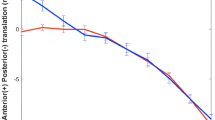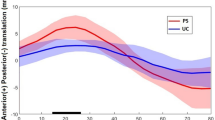Abstract
Purpose
To assess, using model-based dynamic radiostereometric analysis (RSA), the biomechanical behaviour of a new design posterior-stabilized (PS) fixed-bearing (FB) total knee arthroplasty (TKA) in vivo while patients performing two common motor tasks. The hypothesis was that model-based dynamic RSA is able to detect different behaviour of the implant under weight-bearing and non-weight-bearing conditions.
Methods
A cohort of 15 non-consecutive patients was evaluated by dynamic RSA 9 months after TKA implantation. The mean age of patients was 73.4 (65–72) years. The kinematic evaluations were performed using an RSA device (BI-STAND DRX 2) developed in our Institute. The patients were asked to perform two active motor tasks: sit-to-stand in weight-bearing condition; range of motion (ROM) while sitting on the chair. The motion parameters were evaluated using the Grood and Suntay decomposition and the low-point kinematics methods.
Results
The dynamic RSA evaluation showed a significant difference (p < 0.05) between the biomechanical behaviour of the prosthesis during the two motor tasks. When subjected to the patient weight (in the sit-to-stand) the low point of the medial compartment had a shorter motion (5.7 ± 0.2 mm) than the lateral (11.0 ± 0.2 mm). This realizes a medial pivot motion as in the normal knee. In the ROM task, where the patient had no weight on the prosthesis, this difference was not present: the medial compartment had a displacement of 12.7 ± 0.2 mm, while the lateral had 17.3 ± 0.2 mm.
Conclusions
Model-based RSA proved to be an effective tool for the evaluation of TKA biomechanics. In particular, it was able to determine that the fixed-bearing posterior-stabilized TKA design evaluated in this study showed a medial pivoting movement under weight-bearing conditions that was not present when load was not applied. Under loading conditions what drives the pattern of movement is the prosthetic design itself. By the systematic use of this study protocol future comparisons among different implants could be performed, thus contributing significantly to the improvement of TKA design.
Level of evidence
IV.




Similar content being viewed by others
Abbreviations
- PS:
-
Posterior stabilized
- CR:
-
Cruciate retaining
- PCL:
-
Posterior cruciate ligament
- AP:
-
Antero-posterior
- RSA:
-
Roentgen stereophotogrammetric analysis
- FB:
-
Fixed bearing
- TKA:
-
Total knee arthroplasty
- HIPAA:
-
Health Insurance Portability and Accountability Act
- IRB:
-
Institutional Review Board
- VAS:
-
Visual Analogue Scale
- AKSS:
-
American Knee Society Score
- KOOS:
-
Knee Injury and Osteoarthritis Outcome Score
- FU:
-
Follow-up
- AEC:
-
Automatic exposure control
- ROM:
-
Range of motion
- FPS:
-
Frame per second
- MBRSA:
-
Model-based roentgen stereophotogrammetric analysis
- VV:
-
Varus–valgus
References
Banks SA, Markovich GD, Hodge WA (1997) In vivo kinematics of cruciate-retaining and -substituting knee arthroplasties. J Arthroplast 12:297–304
Bignozzi S, Zaffagnini S, Akkawi I, Marko T, Bruni D, Neri MP et al (2014) Three different cruciate-sacrificing TKA designs: minor intraoperative kinematic differences and negligible clinical differences. Knee Surg Sports Traumatol Arthrosc 22:3113–3120
Clary CW, Fitzpatrick CK, Maletsky LP, Rullkoetter PJ (2013) The influence of total knee arthroplasty geometry on mid-flexion stability: an experimental and finite element study. J Biomech 46:1351–1357
Dennis DA (2006) The role of patellar resurfacing in TKA. Point Orthopedics 29:832, 834–835
Dennis DA, Komistek RD, Colwell CE Jr, Ranawat CS, Scott RD, Thornhill TS et al (1998) In vivo anteroposterior femorotibial translation of total knee arthroplasty: a multicenter analysis. Clin Orthop Relat Res 356:47–57
Dennis DA, Komistek RD, Mahfouz MR, Haas BD, Stiehl JB (2003) Multicenter determination of in vivo kinematics after total knee arthroplasty. Clin Orthop Relat Res 416:37–57
Dennis D, Mahfouz M, Komistek R, Hoff W (2005) In vivo determination of normal and anterior cruciate ligament-deficient knee kinematics. J Biomech 38:241–253
Fitzpatrick CK, Clary CW, Laz PJ, Rullkoetter PJ (2012) Relative contributions of design, alignment, and loading variability in knee replacement mechanics. J Orthop Res 30:2015–2024
Fransen BL, van Duijvenbode DC, Hoozemans MJM, Burger BJ (2017) No differences between fixed- and mobile-bearing total knee arthroplasty. Knee Surg Sports Traumatol Arthrosc 25:1757–1777
Freeman M, Pinskerova R V (2005) The movement of the normal tibio-femoral joint. J Biomech 38:197–208
Freeman M, Pinskerova V (2003) The movement of the knee studied by magnetic resonance imaging. Clin Orthop Relat Res 410:35–43
Ginsel BL, Banks SA, Verdonschot N, Andrew Hodge WA (2009) Improving maximum flexion with a posterior cruciate retaining total knee arthroplasty: a fluoroscopic study. Acta Orthop Belg 75:801–807
Grood ES, Suntay WJ (1983) A joint coordinate system for the clinical description of three-dimensional motions: application to the knee. J Biomech Eng 105:136–144
Hsu RW (2006) The management of the patella in total knee arthroplasty. Chang Gung Med J 29:448–457
Iwaki H, Pinskerova V, Freeman M (2000) Tibiofemoral movement 1: the shapes and relative movements of the femur and tibia in the unloaded cadaver knee. J Bone Jt Surg Br 82:1189–1195
JCGM (2008) JCGM100: guide to the expression of uncertainty in measurements. http://www.iso.org/sites/JCGM/GUM-JCGM100.htm
Joglekar S, Gioe T, Yoon P, Schwartz M (2012) Gait analysis comparison of cruciate retaining and substituting TKA following PCL sacrifice. Knee 19:279–285
Johal P, Williams A, Wragg P, Hunt D, Gedroyc W (2005) Tibio-femoral movement in the living knee. A study of weight bearing and non-weight bearing knee kinematics using ‘interventional’ MRI. J Biomech 38:269–276
Komistek R, Dennis D, Mahfouz M (2003) In vivo fluoroscopic analysis of the normal human. Knee Clin Orthop Relat Res 410:69–81
Li G, Zayontz S, Most E, Otterberg E, Sabbag K, Rubash HE (2001) Cruciate-retaining and cruciate-substituting total knee arthroplasty: an in vitro comparison of the kinematics under muscle loads. J Arthroplast 16:150–156
Maruyama S, Yoshiya S, Matsui N, Kuroda R, Kurosaka M (2004) Functional comparison of posterior cruciate-retaining versus posterior stabilized total knee arthroplasty. J Arthroplast 19:349–353
Mine T, Hoshi K, Gamada K, Ihara K, Kawamura H, Kuriyama R, Date R (2016) Kinematic analysis of posterior-stabilized total knee arthroplasty during standing up from and sitting down on a chair. J Orthop Surg Res 11:142
Nakagawa S, Kadoya Y, Todo S, Kobayashi A, Sakamoto H, Freeman M, Yamano Y (2000) Tibiofemoral movement 3: full flexion in the living knee studied by MRI. J Bone Jt Surg Br 82-B:1199–1200
Pandit H, Ward T, Hollinghurst D, Beard DJ, Gill HS, Thomas NP et al (2005) Influence of surface geometry and the cam-post mechanism on the kinematics of total knee replacement. J Bone Jt Surg Br 87:940–945
Pfitzner T, Moewis P, Stein P, Boeth H, Trepczynski A, von Roth P et al (2017) Modifications of femoral component design in multi-radius total knee arthroplasty lead to higher lateral posterior femoro-tibial translation. Knee Surg Sports Traumatol Arthrosc 26(6):1645–1655
Selvik G (1990) Roentgen stereophotogrammetric analysis. Acta Radiol 31:113–126
Tjornild M, Soballe K, Hansen PM, Holm C, Stilling M (2015) Mobile- vs. fixed-bearing total knee replacement. Acta Orthop 86:208–214
van der Voort P, Pijls BG, Nouta KA, Valstar ER, Jacobs WC, Nelissen RG (2013) A systematic review and meta-regression of mobile-bearing versus fixed-bearing total knee replacement in 41 studies. Bone Jt J 95-b:1209–1216
Verra WC, van den Boom LG, Jacobs W, Clement DJ, Wymenga AA, Nelissen RG (2013) Retention versus sacrifice of the posterior cruciate ligament in total knee arthroplasty for treating osteoarthritis. Cochrane Database Syst Rev. https://doi.org/10.1002/14651858.CD004803.pub3
Zaffagnini S, Bignozzi S, Saffarini M, Colle F, Sharma B, Kinov PS et al (2014) Comparison of stability and kinematics of the natural knee versus a PS TKA with a ‘third condyle’. Knee Surg Sports Traumatol Arthrosc 22:1778–1785
Acknowledgements
We acknowledge all the other people involved in this study: radiology technicians, undergraduates, trainees. Their help has been and continue to be of great importance during radiological follow-up and elaboration of RSA images. In alphabetical order: Stefano Durante, Claudia Lopes, Valentina Matti, Rosanna Presicci, Stefania Stramenga, etc.
Funding
The study was partially funded with a grant from the company De Puy Synthes, Johnson & Johnson, Raynham, MA, USA.
Author information
Authors and Affiliations
Contributions
All authors are involved in scientific development of dynamic RSA. All authors have read and approved the final manuscript.
Corresponding author
Ethics declarations
Conflict of interest
The authors declare that they have no competing interests.
Ethical approval
This study obtained the approval from Institutional Review Board (IRB) of Rizzoli Orthopedic Institute (ID: 0035595 October 22, 2015—Clinical Trial Gov ID: NCT02323386).
Rights and permissions
About this article
Cite this article
Bragonzoni, L., Marcheggiani Muccioli, G., Bontempi, M. et al. New design total knee arthroplasty shows medial pivoting movement under weight-bearing conditions. Knee Surg Sports Traumatol Arthrosc 27, 1049–1056 (2019). https://doi.org/10.1007/s00167-018-5243-5
Received:
Accepted:
Published:
Issue Date:
DOI: https://doi.org/10.1007/s00167-018-5243-5




